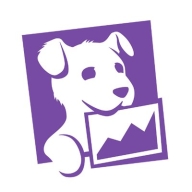

Datadog and Amazon CloudWatch compete in the domain of cloud monitoring services, offering unique features suited for businesses seeking effective monitoring solutions. Datadog seems to have the upper hand due to its easy deployment across various environments and excellent customizability, though CloudWatch may be more appealing for AWS users seeking cost-effective solutions.
Features: Datadog offers extensive integrations, customizable dashboards, and robust logging capabilities. Users can create custom metrics and visualizations easily. In contrast, Amazon CloudWatch integrates seamlessly with AWS and offers essential monitoring features that are cost-effective for AWS environments.
Room for Improvement: Datadog could enhance its querying capabilities and improve cost visibility. Calls for better front-end integration and more granular sharing options are noted. Amazon CloudWatch users seek more advanced monitoring, better real-time data streaming, and integration improvements with third-party and hybrid cloud tools.
Ease of Deployment and Customer Service: Datadog enables seamless deployment across cloud environments and provides proactive customer service. However, its responsiveness can vary. Amazon CloudWatch offers straightforward deployment within AWS but faces challenges with hybrid cloud management. Its customer support is generally positive yet inconsistent.
Pricing and ROI: Datadog’s pricing can be complex, which might lead to high costs with extensive data usage, but users perceive the extensive features as worth the investment. CloudWatch is competitively priced within AWS and offers a budget-friendly option for basic monitoring, though additional features can increase costs as projects expand.
Amazon CloudWatch offers cost-saving advantages by being an inbuilt solution that requires no separate setup or maintenance for monitoring tasks.
While using their cloud and cloud resources, if you have an issue with CloudWatch, you must pay additional monthly fees to get time from dedicated tech support.
In recent years, due to business expansion, knowledge levels among support engineers seem to vary.
Amazon CloudWatch's scalability is managed by AWS.
I sometimes notice slowness when Amazon CloudWatch agents are installed on machines with less capacity, causing me to use other monitoring tools.
When using third-party dashboards such as Kibana or Grafana and other visualization tools, there should be a way to feed CloudWatch's data and logging capabilities into these visualization tools.
Amazon CloudWatch charges extra for custom metrics, which is a significant disadvantage.
Maybe Amazon Web Services can improve by providing a library for CloudWatch with some useful features.
In future updates, I would like to see AI features included in Datadog for monitoring AI spend and usage to make the product more versatile and appealing for the customer.
The documentation is adequate, but team members coming into a project could benefit from more guided, interactive tutorials, ideally leveraging real-world data.
There should be a clearer view of the expenses.
Overall, the pricing of Amazon CloudWatch is very expensive.
Amazon CloudWatch charges more for custom metrics as well as for changes in the timeline.
The setup cost for Datadog is more than $100.
Being an inbuilt solution from AWS, it saves time on installation, setup, and maintenance.
The best features of Amazon CloudWatch need to improve visibility into the network because when using hundreds of network resources such as transit gateway, VPNs, routers, route tables, and firewalls, it does not give many details in a structured manner.
I like its filtering capability and its ability to give the cyber engine insights.
Our architecture is written in several languages, and one area where Datadog particularly shines is in providing first-class support for a multitude of programming languages.
The technology itself is generally very useful.
| Product | Market Share (%) |
|---|---|
| Datadog | 8.5% |
| Amazon CloudWatch | 2.3% |
| Other | 89.2% |


| Company Size | Count |
|---|---|
| Small Business | 17 |
| Midsize Enterprise | 8 |
| Large Enterprise | 24 |
| Company Size | Count |
|---|---|
| Small Business | 78 |
| Midsize Enterprise | 42 |
| Large Enterprise | 82 |
Amazon CloudWatch integrates seamlessly with AWS, providing real-time monitoring and alerting features. Its interface supports task automation, enhancing troubleshooting and analytics capabilities, while offering strong security and scalability at a cost-effective rate.
Amazon CloudWatch is an impactful platform for monitoring AWS resources and managing application performance. It simplifies infrastructure performance monitoring by providing comprehensive analytics capabilities, including application insights and event scheduling. Users appreciate CloudWatch for its detailed metrics, dashboards, and support in issuing alerts to detect anomalies. It efficiently tracks performance, optimizes resource utilization, and ensures service availability. CloudWatch is recognized for its robust alerting features and integration with other AWS services, further supporting its resource monitoring capabilities. However, there is room for improvement in dashboard customization, log streaming speed, and integration with non-AWS services. Enhancements in API integration, machine learning features, and support for third-party tools are also desired.
What features does Amazon CloudWatch offer?Industries implementing Amazon CloudWatch often focus on optimizing IT infrastructure. Companies in sectors like finance and e-commerce rely on its monitoring and alerting capabilities to ensure service uptime and performance. The platform's automation and analytics features empower teams to proactively manage performance and detect potential issues promptly.
Datadog integrates extensive monitoring solutions with features like customizable dashboards and real-time alerting, supporting efficient system management. Its seamless integration capabilities with tools like AWS and Slack make it a critical part of cloud infrastructure monitoring.
Datadog offers centralized logging and monitoring, making troubleshooting fast and efficient. It facilitates performance tracking in cloud environments such as AWS and Azure, utilizing tools like EC2 and APM for service management. Custom metrics and alerts improve the ability to respond to issues swiftly, while real-time tools enhance system responsiveness. However, users express the need for improved query performance, a more intuitive UI, and increased integration capabilities. Concerns about the pricing model's complexity have led to calls for greater transparency and control, and additional advanced customization options are sought. Datadog's implementation requires attention to these aspects, with enhanced documentation and onboarding recommended to reduce the learning curve.
What are Datadog's Key Features?In industries like finance and technology, Datadog is implemented for its monitoring capabilities across cloud architectures. Its ability to aggregate logs and provide a unified view enhances reliability in environments demanding high performance. By leveraging real-time insights and integration with platforms like AWS and Azure, organizations in these sectors efficiently manage their cloud infrastructures, ensuring optimal performance and proactive issue resolution.
We monitor all Cloud Monitoring Software reviews to prevent fraudulent reviews and keep review quality high. We do not post reviews by company employees or direct competitors. We validate each review for authenticity via cross-reference with LinkedIn, and personal follow-up with the reviewer when necessary.